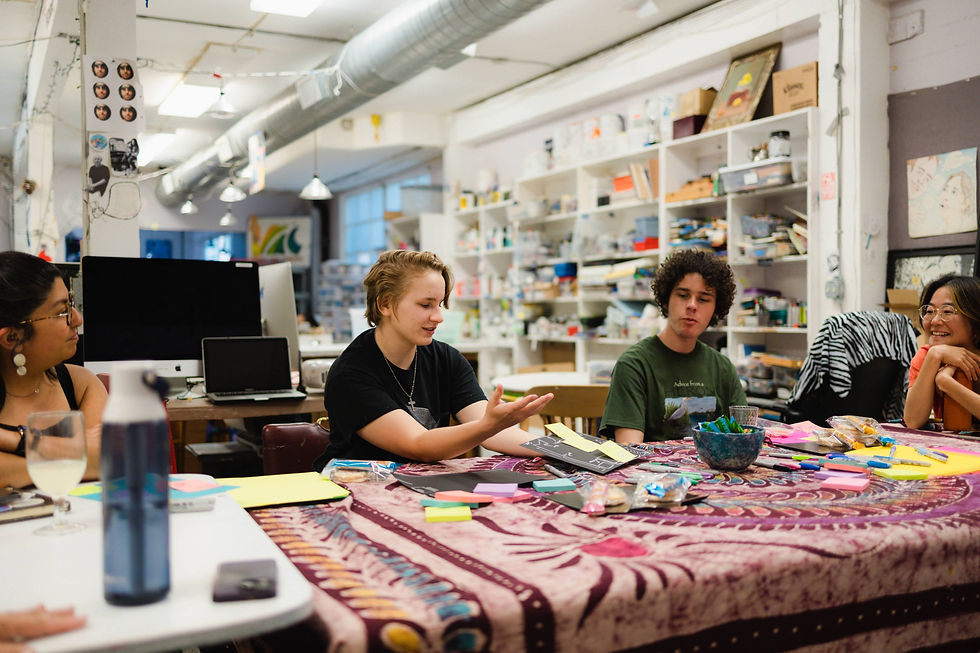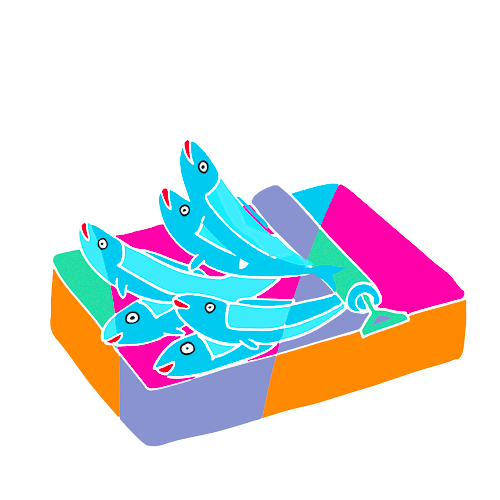Building Connections and Confidence Through Collaboration
- Mai Ryuno
- Aug 20
- 7 min read
Updated: Aug 20
Art has a profound ability to connect people and foster community spirit. The "Speak Not So Easy" project, an eighteen-month art and education initiative, exemplifies this by bringing together young creatives in high school and early college. They collaborated, shared ideas, and co-created meaningful artworks, allowing diverse youth to contribute their creativity to a shared vision. In this post, I'll explore the project's process and the students' learning journey.
My Why for the community art project
Speak Not So Easy is a socially engaged art project that inspired me to think about the idea during the Covid-19 pandemic. My goal is for this project to be a space where students can freely express themselves without concern for others' opinions, especially those of adults. This initiative is deeply rooted in my teaching experiences within both local community colleges and innovative educational programs.
Since 2015, I've had the privilege of teaching art and design at community colleges in Monterey County. Concurrently, I've served as a lead instructor for Y-PLAN at UC Berkeley's Center for Cities + Schools, teaching youth city planning, civic engagement, and leadership. While these subjects may appear disparate, my background helped me connect them.
From 2007 to 2010, I was part of the public education department at the San Francisco Art Institute's City Studio. This program, which was originally a class I took as a student, explored the idea of artists viewing the city as a canvas—not literally, but metaphorically. It highlighted how artistic creativity can extend beyond traditional art forms and practice to impact our everyday lives, communities, and cities.

A key difference between traditional studio art and the "city as studio" practice lies in artist engagement. Traditional art often involves isolation and self-exploration, whereas community-based work demands collaboration.
As an educator, I've observed a lack of collaborative opportunities in art classes. To address this, I've integrated numerous collaborative projects into my art classes at community colleges. For instance, our drawing class once submitted group projects to a student show, organized by a faculty member. He was genuinely surprised to see large-scale drawings created by groups of my students and commented on my bravery in fostering such teamwork. While some students preferred individual work, I persisted in creating these opportunities.

My Drawing and Composition class, which I've taught since the beginning of my college teaching career, requires students to develop specific drawing skills. Inclusion of collaborative projects for this technical class became more challenging with the shift to online learning during the pandemic. However, teaching 3D design online offered unexpected freedom for students and me to explore diverse ideas, materials, and collaborations beyond the classroom. This class allowed me to introduce the "city/community as studio" concept within a 3D space, despite the difficulties of virtual collaboration.
In the 3D design classes, students designed public spaces with social issues such as homelessness in mind, sparking important class discussions about their personal experiences. Other topics included immigration, mental health, and gender, prompting students to develop ideas and designs for improvement. These were incredibly enriching teaching and learning experiences for me, and I hope for my students as well.
Video about a class conversation on hostile design:
At the same time, my Y-PLAN teaching was temporarily suspended during the pandemic due to the travel requirements of the summer program, which was canceled in 2020 and 2021. This pause led me to reflect on my experiences teaching innovative educational programs, most of which were held outside my residential community. Participants in such programs are typically proactive and willing to take initiative without explicit instructions from instructors or adults. I noticed fewer similar opportunities within our community and a growing comfort among students in staying within their comfort zones.

Collaborative projects in these art and design classes offered a meaningful solution to students when many social interactions, including classroom learning, shifted online. They provided unique opportunities for young people to build more authentic connection even online, encouraging dialogue, and mutual understanding. This experience could be instrumental in breaking down barriers stemming from socio-economic differences, as well as personal or cultural divisions. However, I thought that this engagement was confined to the online classroom, while the real impact needs to occur within the community.
Therefore, I felt compelled to combine my art and teaching expertise to create a project that offers real-world learning opportunities to young people in my community. This endeavor ultimately became the Speak Not So Easy project.
The Power of individuals in Community Building
Collaboration was at the heart of the Speak Not So Easy project including community collaboration. To recruit participants, I connected with local artists, schools, and various art and community organizations in fall 2023. I was grateful for the opportunity to host introductory workshops at the Monterey Museum of Art, Monterey High School's AMP Academy, and the Youth Arts Collective (YAC), from which four students joined the project. This initiative was also supported by an Individual Artist Grant from the Arts Council for Monterey County. All the participating students were members of YAC, and Marissa Serna, the organization's program director, provided invaluable support for communication and project development.
The project began with a workshop where I asked students, "Are you happy about your everyday life?" To answer this, participants explored their daily routines, identifying sources of happiness and unhappiness by creating "everyday life maps." As an icebreaker, they shared their answers and drawings of their daily environments and activities. While the Monterey Peninsula is a beautiful place with rich history and nature, which can sometimes create an illusion that all is well, I've observed strong community resistance to new ideas, such as a skateboard park or a rainbow crosswalk. (The rainbow crosswalk was ultimately funded by the LGBTQ+ community after the city was unable to provide full support.)

Initially, I planned to dive directly into a community project. However, I soon realized that students needed to feel comfortable working together and confident in expressing themselves. My approach shifted from a direct community project to one focused on self-discovery with a community element. Facilitated by me and led by the students, we held weekly Sunday meetings. During these sessions, we discussed what was missing from their communities and their personal values, applying these insights to broader community and societal contexts. Although I initially anticipated the project would last about a year, it extended to a year and a half, culminating in two main projects: individual video art and a collaborative public art installation.

Our meetings became a space where students openly shared their life experiences, feelings, and perspectives, sometimes leading to tears. For me, as an artist, the true beauty of "Speak Not So Easy" lay in these moments where participants could be their authentic selves and share freely, bringing us closer despite our differences.
The first phase of the project resulted in three video artworks exploring themes of authentic communication, gender/human relationship issues, and the quality of life in a fast-paced society. To foster community engagement, a core purpose of the video artworks, the students hosted a screening event at YAC to facilitate community conversations.
From Self-Discovery to Community Action
Our second project developed from our discussions and individual video artworks, shifted our focus from individual identities to our collective identity. Students identified a common desire for a community where everyone is treated with humanity and is open to change. They aimed to create a space for reflection, inspiration, and empowerment.
Students' initial concept for a structure for their public installation was quite elaborate, requiring significant time and labor. We faced some challenges as everyone's busy schedule for which a couple of students had to leave the project, though new collaborators occasionally joined to offer insights. The students also expressed some initial uncertainty about working on the collaborative project, even after nearly a year of collaboration, which you can see in this video.
We then focused on the concept of community, leading to the core ideas of "We are all humans" and "Community of change." The students envisioned a dynamic community, but recognized the need for a dedicated space and time for people to openly discuss these ideas. This led to the design of a structure emphasizing transparency and openness, yet also providing a safe and intimate environment through the use of transparent and flexible fabric walls. This installation was placed in a public space by the Cannery Raw in Monterey, encouraging participation from both locals and tourists.
The Umbrella of Humanity: A Public Installation
The Umbrella of Humanity is a participatory public art installation created by the Speak Not So Easy's young creatives, a.k.a. Futuremakers. This project is designed as an internal communication space to foster transparency and organic interaction among participants. We intentionally moved away from rigid structures to encourage a natural flow of conversation and cultivate open communication within our community, acknowledging shared human experiences and similarities despite our differences. We believe that recognizing our common experiences can foster stronger connections, and this platform also celebrates individuality within our broader community.

The transparent "walls" of the installation symbolize an openness to new perspectives, both internally and externally. Its organic and flowing shape represents the dynamic nature of our community and the changes we experience together. The overarching "umbrella" shape signifies the broader concept of our community while embracing the enriching perspectives of each individual. The installation transformed as participants collectively shared their thoughts through conversations and writings on uniquely shaped and vibrant fabrics, pinned to the walls.
It was intended to be a physical space where connections began and flourished between individuals who might not otherwise cross paths, fostering connections based on the simple truth that we are all human beings.
After the installation, an article about "The Umbrella of Humanity" was published in the Monterey County Weekly.
We implemented the installation on Mother's Day and observed many families passing by. Our first participants were curious children who brought adults into the art project. The students noted that children often exhibit more curiosity than adults when exploring something unknown or unfamiliar.

The Final Impact and what's next
This collaborative project proved that art is far more than an aesthetic object. It's a space for young people to be heard, to be vulnerable, and to inspire a sense of community that can often feel lost. At their core, both the video art and the public installation were about fostering unity, cooperation, and a shared sense of purpose. In an era where many feel isolated, these artworks built essential connections and provided a platform for genuine dialogue.
As UNESCO has highlighted, art can serve as a catalyst for social change. By creating these pieces, the young artists were able to engage in critical conversations, amplify their voices, and strengthen community ties.
This initiative will continue to serve as a case study for the Play Full Ground creative micro high school, reinforcing our belief that the most profound value of art lies in its ability to bring people together.











Comments